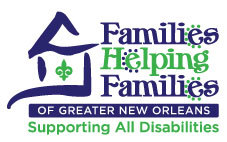The Fatal Five in Individual Developmental Disabilities
Warning signs, risk factors, and what to do for individuals with developmental disabilities regarding aspiration, constipation, dehydration, seizures, and sepsis. Treatment and management of healthcare needs among individuals with IDD can be challenging. Individuals with IDD have unique needs that are not always consistent with those of the general population. Additionally, many of these individuals cannot verbalize symptoms, and behaviors may mask the signs of life-threatening conditions.
Source: Relias
A Guide to Behavioral Health Resources in the Greater New Orleans Area
This guide provides a comprehensive inventory of all behavioral health resources, including important programs, and clinics offered by area providers and organizations from the public and private sectors.
Source: City of New Orleans Health Department
ATN/AIR-P Puberty and Adolescence Resource: A Guide for Parents
All parents eventually face the challenge of teaching their children about the natural changes of puberty. However, parents of pre-teens with ASD may need the help of additional strategies to ease the transition. Our aim in developing this tool is to provide guidance on the subject of puberty that can be directly applied to pre-teens with ASD. In doing so, we hope to increase families’ understanding of puberty and their ability to adapt to these changes with confidence.
Source: AutsimSpeaks
Eight 1 minute anxiety relief tools for kids big and small
Eight research-based ideas you can try with your kids when they’re feeling stressed or anxious.
Source: The Huffington Post
EPSDT – A Guide for States: Coverage in the Medicaid Benefit for Children and Adolescents
The Medicaid program’s benefit for children and adolescents is known as Early and Periodic Screening, Diagnostic and Treatment services, or EPSDT. EPSDT provides a comprehensive array of prevention, diagnostic, and treatment services for low-income infants, children, and adolescents under age 21, as specified in Section 1905(r) of the Social Security Act (the Act). The EPSDT benefit is more robust than the Medicaid benefit for adults and is designed to assure that children receive early detection and care so that health problems are averted or diagnosed and treated as early as possible. The goal of EPSDT is to ensure that individual children get the health care they need when they need it – the right care for the right child at the right time in the right setting.
Source: CMS
Got Transition
A website dedicated to health care transition. Learn how to prepare, find adult healthcare providers, track your health information, manage your own healthcare needs, and more. The website is in both English and Spanish.
Heath Transition Readiness Assessment for Youth
A checklist for youth to help determine their readiness for health transition.
Source: Got Transition
How to Discuss Puberty with Your Child who has Special Needs
It’s not easy to talk to any child about how our bodies change during puberty. But how can it be explained to a child with special needs who may or may not understand? This website gives 10 great tips on how to discuss this with your child who has special needs.
Medicaid Diaper Program
The Medicaid Diaper Program provides diapers and/or pull-ups for individuals between the ages of 4 – 20 years old, with an appropriate referral from your physician. Click on the link to access instructions.
Source: Medicaid
Medication Safety
Giving kids medicine safely can be complicated. And many parents feel the pressure when a young child needs certain medications, knowing that giving too much or too little could cause serious side effects. But with a little knowledge and a lot of double-checking, you can give your kids medicine safely and prevent dangerous reactions.
Source: KidsHealth
Childhood Immunizations Resources
Resources on immunizations.
Source: Center for Disease Control
Preventing Suicide: A Toolkit for High Schools
This toolkit was funded by the U.S. Substance Abuse and Mental Health Services Administration to help high schools, school districts, and their partners’ design and implement strategies to prevent suicide and promote behavioral health among their students.
Source: Substance Abuse and Mental Health Services Administration (SAMHSA)
Smooth Moves to Youth Health Transition Website
SmoothMovesYHT is a health information site created to help teens navigate the move to adulthood. If you are age 14-17, this site is created just for you! YHT is important for all youth! That includes youth with and without a special health care need or disability. The site offers up-to-date info and links to tools which can help you get ready for a smooth transition to adulthood. In this site, you will also find skill-building activities and even games! SmoothMovesYHT is a tool to help you set goals for the future YOU want!!
Source: Smooth Moves YHT
Take Charge: A Reproductive Health Guide for Women with Disabilities
A guide to help you understand your reproductive rights as a woman and your civil rights as a person living with a disability; offer suggestions on how to self-advocate to exercise these rights and overcome barriers that could result in denial of your care or in services that are unsafe or of poor quality; help you understand your right to become a mother with resources for raising your children and inform you of the resources available if you are experiencing domestic or sexual abuse.
Source: Access Living
Updated 3/6/2023
